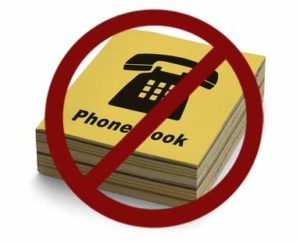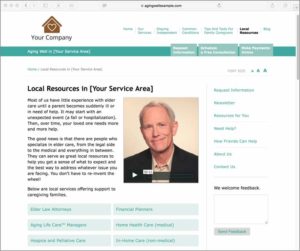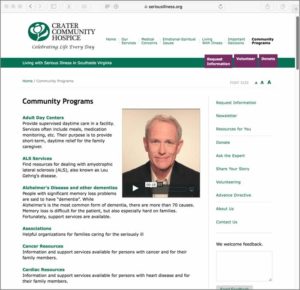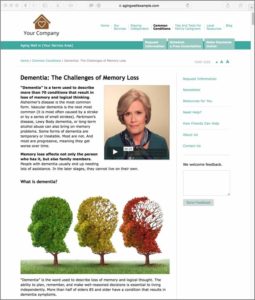
Elder care is not like e-commerce. We can’t look at shopping cart totals and know what worked best.
For elder care providers, the best website viewers are those who ultimately pick up the phone. They want to learn more, and hopefully this will lead to an admission or contract. I’ll take three visitors who pick up the phone over 100 who come to the site and then leave.
The next best to picking up the phone is filling out a form to start a relationship:
- Send information
- Schedule a consultation
- Sign up for a workshop or presentation
- Subscribe to your e-newsletter
How to attract the “best” viewers?
It helps to reflect on your best contacts based on referral source IRL (in real life).
- A referral from a professional is highly likely to sign on.
- A word-of-mouth recommendation from one of your clients is also a pretty good bet.
- Someone who finds you having simply looked in the “Yellow Pages,” not as likely.
Translating to the Web
- A referral from another professional, in the Web world, translates to a colleague putting a link to your website on his or her site.
- Word-of-mouth recommendation from a friend is a LIKE, comment, or share on Facebook or LinkedIn. Or a forwarding of your e-newsletter.
- Someone who finds you in the Yellow Pages is the equivalent to a cold search on Google (e.g., “Hospice in ***Location***” or “Care Manager in ***Location***”). They are likely “shopping,” and you are one of several options at the beginning of their research. There’s a very low commitment unless they have heard about you in another context and the search is for your company name in particular.
Analytics bear this out
People who arrive at your website from a link on another website will stay significantly longer (2-4 minutes) as opposed to those who come from a search (less than 2 minutes, with half staying 60 seconds or less). Amount of time on a website, and indeed, the number of pages clicked, is a pretty good indicator of depth of interest.—ergo quality viewer. After all, if a site is not delivering what the person is after, it’s easy to walk away. And people readily vote with their feet—or mouse, as the case may be.
The value of links on someone else’s page
The hands-down BEST way to increase both the quantity and quality of your visitors is to get allied businesses to link to you. In fact, 25% of viewers will likely get to your website from a link on another page. This works for you in several ways:
- You get prescreened visitors. They are already interested in your topic. After all, who knows what someone was searching for on Google or Bing. “Senior” as a keyword search could have been intended to mean fourth year in college! But a person on an adult day center site or a person on the website of an elder law attorney is already showing interest in elder issues.
- The process of cross-linking is great networking. I had one hospice client call a local medical supply house to see if they would add a link, and the two got into a fantastic discussion. It turns out that the competing hospice had its own DME service, so when the supplier’s customers went there, the supplier lost business. That medical supplier was very happy to promote my client’s hospice and invited him to drop off his hospice’s brochures regularly, and they were kept on display at the counter.
- Search engines love incoming links. The more incoming links, the higher you will go on a search engine results page. Search engines interpret incoming links as a cyberspace word-of-mouth recommendation, which it sort of is. A link to you speaks to your credibility and people’s willingness to send their viewers to your page. As a result, the more incoming links you have, the “higher your authority” in the search algorithms.
Reciprocal linking
The easiest way to get incoming links is to give what you hope to receive. In other words, set up a “Local Resources” page and liberally populate it with the name, phone number, and website links of your referrers. Then call up those referrers, point out that you have listed them on your Local Resources page. Ask if they would be willing to add a link to your website on their pages.
You might even use the opportunity to set up an informational interview to find out “how best to refer” to you (e.g., a care manager calling an elder law attorney). Make the visit about them and their business. They likely will, out of politeness, ask about your business, and you can be ready with your tailored elevator pitch about how you make their life easier. By creating a face-to-face networking opportunity, you promote more engagement and a higher likelihood of their thinking of you the next time they have a client in need of your services.
My hospice and home health clients even set up an online directory of Community Programs.
In addition to many options for reciprocal linking, an online directory makes for a highly “bookmarkable” site since referrers can use it to look up all kinds of local services. The more you can get in front of your referrers with useful resources that make their lives easier, the stronger the bond they will feel with you.
And don’t forget, every page they print out for a client has your name, logo and contact information. They are passing along your brand! That is the beauty of content marketing.
Post link-worthy resources
Some referrers might be cautious about putting a link to your company page. If you are a hospice, they might worry about being associated with the “H” word. If you are a home care company or care manager and they are an attorney, they may worry that a link appears to endorse you.
Offer your professional colleagues a link to educational resources with your branding. Write articles that are of interest to your shared client base: family caregivers. “Dementia: The Challenges of Memory Loss“ “Dealing with Family“ or “Managing Pain“ or whatever is appropriate for your mutual clientele.
Who stays the longest?
We started this blogpost with the premise that Web viewers who stay the longest are the highest quality viewers. This is true. And the viewers who stay the longest are the ones who directly type in your Web address. These folks are active service seekers and are usually responding to your own marketing collateral (e.g., brochures, PSAs, print newsletters, a presentation you gave). As such, they are already far down the sales funnel and are closer to making a decision than is the average Web viewer coming from another website or search.
Lesson to learn here?
Just as IRL (in real life), for QUALITY viewers, nothing beats having a direct relationship. That takes time, though. Many people hope to skimp and rely on search engine optimization. You can try. And you may get more traffic—quantity. That might be useful for a business based on impulse buying. But people looking for elder care who come from a cold search typically don’t stay long and are not nearly as likely to pick up the phone and call.
In the digital age, the best way to boost the quality of your viewers is by creating link-worthy content and focusing on getting allied businesses to put a link to your branded materials.
If you would like to learn more about content marketing for hospice, care managers, home care or home health, give me a call at 707-477-0700 (Pacific). Or check out our website.








